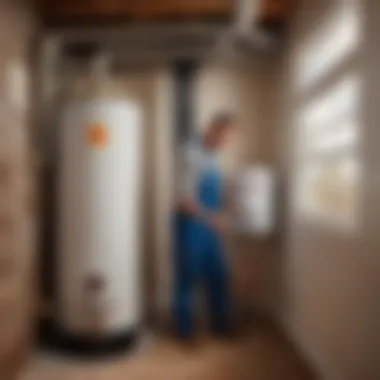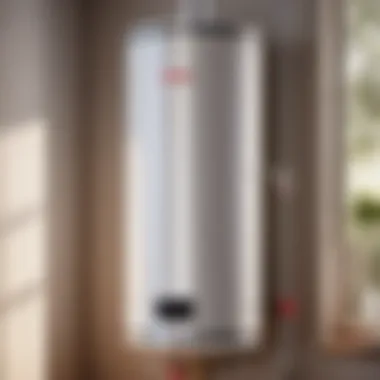Materials:
- 40-gallon hot water heater tank
- Steel water supply lines (2)
- Wire nuts
- Teflon tape
- Pressure relief valve
- 3/4-inch copper tubing
- Pipe fittings (various sizes)
- Adjustable wrench
- Pipe wrench
- Screwdriver
- Bucket
- Voltage tester
- Pipe cutter
- Tape measure
DIY Steps:
-
Turn off any water supply: Locate the main water supply valve and shut it off to ensure safety during installation.
-
Drain the old water heater: Connect a garden hose to the drain valve on the old water heater and drain the tank completely.
-
Disconnect old water heater: Remove any connections to the old water heater and carefully lift it out of place.
-
Prepare the new water heater: Position the new water heater in place and connect any necessary fittings.
-
Connect water supply lines: Install the steel water supply lines, ensuring they are secure and leak-free.
-
Connect the pressure relief valve: Attach the pressure relief valve according to manufacturer instructions.
-
Connect the copper tubing: Use the copper tubing to connect the hot and cold water lines to the corresponding fittings on the new water heater.
-
Adjust fittings: Use the adjustable wrench to tighten any fittings to avoid leaks.
Technical Aspects:
- Installation time: Approximately 2-3 hours
- Tools required: Adjustable wrench, pipe wrench, screwdriver, voltage tester, pipe cutter, tape measure
- Critical techniques: Ensuring all fittings are tight and secure, proper alignment of water supply lines, following manufacturer guidelines for pressure relief valve installation.
DIY Project Process:


-
Begin by turning off the water supply and draining the old water heater.
-
Disconnect the old water heater and prepare the new one for installation.
-
Connect the water supply lines, pressure relief valve, and copper tubing according to manufacturer instructions.
-
Check all connections for leaks and adjust fittings as needed.
Troubleshooting Tips:


- If there are leaks after installation, check all fittings and connections for tightness.
- Ensure the pressure relief valve is properly installed and functioning.
- If the water heater is not heating water, check the power source and thermostat settings.
Introduction


When it comes to the comfort and functionality of a home, a properly installed hot water heater plays a crucial role. In this article, we delve deep into the intricate process of installing a hot water heater, ensuring that every step is executed with precision and care. From understanding the significance of a correct installation to exploring the myriad benefits and considerations associated with this task, readers will be equipped with the knowledge needed to tackle this project efficiently.
Understanding the Importance of Proper Hot Water Heater Installation
Proper hot water heater installation is not just about convenience; it is about safety, efficiency, and longevity. Ensuring that your heater is installed correctly guarantees that it operates at its optimal capacity, providing you with a steady supply of hot water when you need it most. By following the recommended installation procedures, you not only enhance the performance of the heater but also reduce the risk of malfunctions or breakdowns in the future. It's a vital investment in both the comfort of your home and the well-being of its occupants.
Benefits of Installing a Hot Water Heater Correctly
The benefits of installing a hot water heater correctly are plentiful. Firstly, a properly installed heater is more energy-efficient, leading to lower utility bills over time. Additionally, it ensures that hot water is delivered consistently and at the desired temperature, enhancing your daily routines. Correct installation also minimizes the chances of leaks, corrosion, or other issues that could result from improper setup, saving you from costly repairs or replacements down the line. Overall, investing time and effort in installing your hot water heater the right way pays off in comfort, savings, and peace of mind.
Overview of the Installation Process
The installation process of a hot water heater can seem daunting at first, but with the right guidance, it becomes a manageable task. From preparing the installation area to connecting water supply lines and ensuring proper ventilation, each step is essential to the success and longevity of your heater. By following a systematic approach and adhering to safety precautions, you can navigate through the installation smoothly and confidently. This overview provides a roadmap for a seamless installation experience, highlighting the critical steps and considerations that homeowners need to keep in mind.
Preparing for Installation
When embarking on the installation of a hot water heater, the initial step is crucial in ensuring a seamless and efficient process. Proper preparation sets the foundation for a successful outcome, safeguarding against potential challenges and ensuring the safety of those involved. This section focuses on the meticulous planning and organizing required before diving into the physical installation, emphasizing the significance of attention to detail and foresight.
Gathering Necessary Tools and Materials
Before beginning the installation, it is imperative to gather the essential tools and materials necessary for the task at hand. Each item serves a specific purpose, contributing to the overall efficiency and accuracy of the installation process.
Wrench
The wrench plays a vital role in securing and tightening various components of the hot water heater. Its adjustable design allows for versatility in tackling different sizes of nuts and bolts, ensuring a snug fit for leak-free connections. The ergonomic handle provides comfort during use, reducing hand fatigue and improving overall workmanship. The wrench's durability and reliability make it a popular choice among professionals and DIY enthusiasts alike, offering precise control and ease of use in tight spaces.
Pipe Cutter
A pipe cutter is essential for accurately cutting pipes to the required length without causing damage or deformation. Its sharp cutting wheel ensures clean and smooth cuts, facilitating seamless connections between pipes and fittings. The compact size of the pipe cutter allows for maneuverability in restricted areas, enabling precise cuts even in confined spaces. Its efficiency in cutting various types of piping materials makes it a valuable asset in the installation process, enhancing the overall quality and durability of the system.
Teflon Tape
Teflon tape, also known as thread seal tape, plays a crucial role in preventing leaks in threaded pipe connections. Its high-density material effectively seals joints, preventing water or gas leaks in the system. The versatility of Teflon tape allows for easy application and reapplication, ensuring a secure seal with minimal effort. Its resistance to corrosion and chemical agents enhances the longevity of connections, contributing to the system's reliability and performance.
Level
The level serves as a fundamental tool for maintaining the horizontal and vertical alignment of the hot water heater during installation. Ensuring the proper positioning of the heater is essential for its functionality and safety. The level's clear vial and precise measurements enable accurate alignment, preventing potential issues such as leaks or operational inefficiencies. Its compact size and easy readability make it a valuable asset in achieving a professional installation outcome, reflecting attention to detail and precision in the overall setup.
Installing the Hot Water Heater
In this crucial section of the installation process of a hot water heater, the focus shifts to connecting the water supply accurately. Properly connecting the inlet and outlet pipes, ensuring electrical connections are secure, and meeting the necessary venting requirements are essential for a successful installation. Each step plays a vital role in ensuring the heater functions optimally and safely, providing hot water efficiently.
Connecting Water Supply
Attaching Inlet and Outlet Pipes
When attaching the inlet and outlet pipes during the installation of a hot water heater, it is imperative to use quality materials and fittings to prevent leaks and ensure smooth water flow. The correct attachment of these pipes guarantees the heater receives and distributes water effectively, contributing to its overall performance. By securely fastening the pipes, you minimize the risk of malfunctions and enhance the heater's longevity. Additionally, selecting the appropriate pipe sizes and materials compatible with the heater's specifications is crucial to maintain consistent water pressure and temperature.
Using Appropriate Fittings
Choosing the correct fittings for connecting the water supply is vital to the seamless operation of the hot water heater. The fittings serve as connectors between pipes, ensuring a tight and leak-free connection. Utilizing fittings that match the pipe material and diameter is essential for secure water flow and preventing any potential damage or inefficiencies. By selecting fittings specifically designed for hot water systems, you enhance the heater's reliability and reduce the likelihood of future maintenance issues.
Securing Connections
Securing the connections between the water supply components is a critical step in the installation process. Properly secured connections minimize the risk of leaks, ensuring the system functions efficiently. By using appropriate tools and techniques to secure the connections tightly, you maintain the integrity of the water supply system and prevent potential water damage. Regularly inspecting and reinforcing these connections is advisable to identify and address any weak points promptly, guaranteeing uninterrupted hot water supply.
Final Steps and Testing
In the final steps of installing your hot water heater, it is crucial to ensure that everything is in order before starting it up. Testing the heater properly plays a vital role in guaranteeing its functionality and safety. Focusing on the final steps and testing phase not only completes the installation process but also sets the stage for a reliable and efficient hot water supply in your home. This section covers the essential elements of filling and testing the heater, making adjustments, troubleshooting common issues, and providing maintenance tips for longevity.
Filling and Testing the Heater
Filling the tank
When it comes to filling the tank of your hot water heater, precision is key. Properly filling the tank ensures optimal performance and longevity of the unit. By carefully filling the tank to the recommended level, you prevent issues such as overheating or inadequate hot water supply. One of the key advantages of filling the tank correctly is the extended lifespan of the heater due to reduced strain on its components. The unique feature of filling the tank lies in achieving the perfect balance of water volume to meet your household's hot water demands efficiently.
Checking for leaks
Checking for leaks is a critical step in the testing process of a hot water heater installation. Detecting and addressing leaks promptly can prevent water damage to your property and ensure the heater operates as intended. By inspecting all connections and fittings for leaks, you maintain the integrity of the system and avoid potential hazards such as flooding or water wastage. The advantage of this meticulous check is early leak detection, which can save you from costly repairs or replacements down the line. The unique feature of checking for leaks is the peace of mind it provides, knowing that your hot water system is leak-free and secure.
Testing hot water flow
Testing the hot water flow post-installation confirms that the heater is functioning correctly and delivering hot water at the desired temperature and pressure. This test verifies the efficiency of the system and ensures a steady flow of hot water for your daily needs. By conducting this test, you validate the installation process and guarantee a seamless hot water supply for your household. The advantage of testing hot water flow is the immediate feedback it provides on the system's performance, allowing for any necessary adjustments or corrections. The unique feature of testing hot water flow is its direct correlation to the operational success of the hot water heater, providing assurance of its reliability.
Adjustments and Troubleshooting
Adjusting temperature settings
Adjusting the temperature settings of your hot water heater is essential for optimizing its efficiency and meeting your specific hot water requirements. Fine-tuning the temperature ensures comfort and prevents energy wastage. By customizing the temperature settings to suit your household's needs, you enhance the heater's performance and reduce energy costs. The key characteristic of adjusting temperature settings is the personalized control it offers, allowing you to tailor your hot water supply to different usage scenarios effortlessly.
Troubleshooting common issues
Troubleshooting common issues related to hot water heaters involves identifying and resolving problems that may arise during operation. From fluctuating temperatures to strange noises, addressing these issues promptly can prevent further damage and maintain the heater's functionality. By troubleshooting common issues, you prolong the lifespan of the heater and ensure uninterrupted hot water supply. The key characteristic of troubleshooting is the ability to diagnose and rectify problems swiftly, enhancing the overall performance of the system.
Seeking professional help if needed
Seeking professional help for complex issues or uncertainties regarding your hot water heater is a wise decision to ensure safety and proper functionality. Professional plumbers have the expertise and experience to handle intricate problems and provide reliable solutions. By engaging the services of a qualified professional, you can avoid potential risks associated with DIY repairs and installations, safeguarding your investment in the hot water system. The key characteristic of seeking professional help is the assurance of professional standards and expertise in resolving any challenges effectively.
Maintenance Tips for Longevity
Regular inspection
Performing regular inspections of your hot water heater is essential for detecting any potential issues early and maintaining its efficiency. Regular checks help prevent major malfunctions and extend the lifespan of the heater. By inspecting components, connections, and overall performance regularly, you ensure the continuous and safe operation of the system. The key characteristic of regular inspection is the proactive approach it offers in identifying and addressing problems before they escalate, leading to cost-effective maintenance.
Flushing the tank
Flushing the tank of your hot water heater removes sediments and mineral buildup, enhancing its performance and efficiency. Regular flushing prevents clogs, maintains water quality, and prolongs the heater's lifespan. By flushing the tank periodically, you ensure optimal heating capacity and reduce the risk of damage due to sediment accumulation. The key characteristic of flushing the tank is the revitalization of the heater's functionality, improving heat transfer and overall performance.
Replacing anode rods
Replacing the anode rods of your hot water heater is essential for preventing corrosion and extending the unit's lifespan. Anode rods sacrifice themselves to protect the tank from rust and corrosion, so regular replacement is crucial for the heater's longevity. By replacing anode rods as recommended by the manufacturer, you preserve the integrity of the tank and maintain water quality. The unique feature of replacing anode rods lies in their sacrificial role, prolonging the heater's lifespan by preventing premature tank failure.





